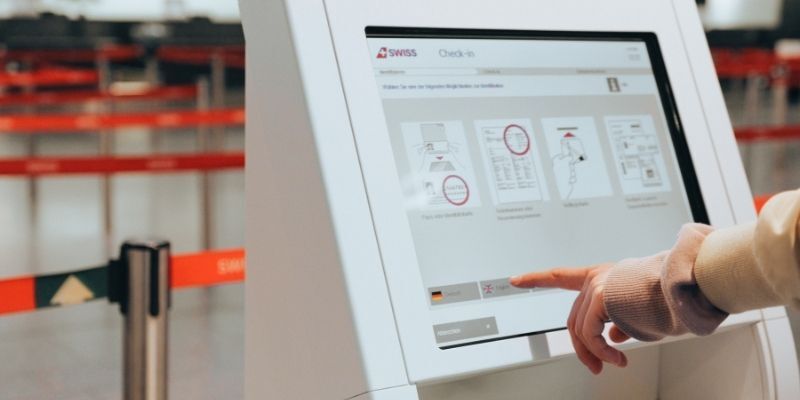Airports are facing a new set of challenges. Since the pandemic, passenger numbers have returned, but so have rising expectations.
Travelers are looking for quicker check-ins, fewer delays, and a smoother journey from start to finish. Meanwhile, airport operators are dealing with tighter staffing, aging infrastructure, and pressure to do more with less.
To keep up, many airports are turning to technology, not as a luxury but as a necessity. From improving operational efficiency to creating more personalized experiences, airports are finding new ways to meet the needs of today’s travelers while keeping operations running smoothly.
In this article, we’re focusing on 10 key technology and CX innovations in airports that are helping facilities worldwide meet these demands.
Backed by real-world examples and early success stories, these innovations show how airports can improve passenger experience and operations.
Top 10 Technology & CX Innovations in Airports

Airports face increasing demands to improve their operations and the overall passenger experience. To meet these demands, many are implementing new technologies that help streamline operations and make the travel experience more efficient and enjoyable.
Here’s a look at 10 technology and CX innovations at airports that are improving air travel:
1. Robotics & Automation in Airport Ops
Robots are becoming essential in airport operations, with autonomous tugs, cleaning robots, and service bots helping improve turnaround times and maintain smooth, efficient operations.
These robots are not just about convenience; they’re helping airports cut down on delays and improve hygiene, which has been a top priority since the pandemic. For example, autonomous cleaning technology is booming and expected to grow 22.9% annually by 2030.
Airports like Changi and Heathrow are already seeing the benefits of robotics, with fewer staffing delays, faster turnaround times, and more efficient operations.
At Hamad International Airport in Qatar, robots enhance hygiene and streamline operations. In preparation for the post-COVID-19 era, the airport introduced disinfectant robots that sanitize high-touch areas, ensuring passengers a cleaner and safer environment.
As these technologies develop, they are helping increase efficiency and enhance the overall passenger experience.
2. AI for Predictive Operations and Crowd Flow
Artificial intelligence is helping airports stay one step ahead by predicting potential bottlenecks and optimizing gate allocation, staffing, and crowd flow.
Using AI-powered tools, airports can better predict flight delays and streamline ground operations, which helps reduce wait times and improve overall efficiency.
Integrating AI into systems like the Airport Operational Database (AODB) or resource management platforms makes it easier for airports to anticipate needs and adjust resources in real time.
These AI tools make airport operations smoother and enhance the passenger experience by ensuring less time spent in lines and more predictable travel times.
3. Seamless Travel with Biometric Identity

Biometric technology is making air travel faster and more secure. Biometric boarding, eGates, and Digital Travel Credentials (DTCs) allow passengers to move through airports with minimal friction.
Supported by initiatives from organizations like ICAO, these technologies are gradually replacing paper-based checks and making identity verification quicker and more secure.
By the end of 2025, the number of digital ID verification checks is expected to reach 86 billion, a sign of the growing demand for paperless travel. Airports using biometric systems are experiencing smoother processes, fewer delays, and an overall better passenger experience.
4. Passenger-Centric Personalization Platforms
Modern airports are using data-driven platforms to offer more personalized experiences. By analyzing passenger data, these systems can provide timely alerts, personalized retail offers, and real-time gate change notifications, enhancing airport customer experience at every journey stage.
Integration with loyalty programs further allows airports to offer exclusive deals and upsell opportunities to frequent flyers.
However, with the collection of personal data comes the responsibility to protect it. Compliance with data privacy regulations, such as the General Data Protection Regulation (GDPR), is important.
Airports must ensure that passenger data is handled transparently and securely, helping travelers feel confident that their information is protected.
5. AR/VR for Training and Wayfinding
Augmented Reality (AR) and Virtual Reality (VR) technologies are improving how airports manage operations and assist passengers with navigation.
For staff training, VR simulations offer immersive environments where baggage handlers and ground crew can practice procedures without the risks associated with real-world training.
For example, ANA Group introduced a VR ground handling simulator called ∀TRAS, enabling staff to train on tasks like aircraft pushback and de-icing in a controlled setting.
Passengers benefit from AR-based wayfinding tools that overlay directions onto their smartphone screens, guiding them seamlessly through complex terminals. These technologies improve operational efficiency and enhance accessibility for travelers with special needs.
Moreover, airports implementing AR and VR solutions have reported a 10% increase in operational efficiency, thanks to smoother training processes and better passenger navigation.
6. Touchless & Contactless Technology Rollout

After the pandemic, airports have been moving quickly to bring in touchless technology to keep travelers safe and make the airport experience smoother.
Things like mobile ID check-ins, contactless kiosks, and digital wallets help reduce touching shared surfaces, lowering the risk of spreading germs. They also help move people through security and check-in faster.
To ensure these tools help, airports need to roll them out gradually and make it easy for travelers to understand how to use them.
That means putting up clear signs, training staff to assist, and offering simple instructions so people feel comfortable with mobile apps and self service kiosks.
It’s a significant move to improve the customer experience with digital tools, especially for today’s tech-savvy travelers.
For example, Delta partnered with Wavetec to deploy self-service kiosks at airport lounges, enhancing passenger experience and operational efficiency.
These kiosks offer paperless ticketing, real-time queue updates, and seamless feedback mechanisms, reducing wait times and improving satisfaction for lounge guests.
7. IoT for Real-Time Asset and Environment Monitoring
Airports are using IoT technology to monitor essential assets and environmental conditions in real time.
Sensors installed on baggage trolleys, HVAC systems, lighting, and even washrooms provide continuous updates that help staff respond quickly to usage patterns and maintenance needs.
For example, washroom sensors can alert cleaning crews based on actual foot traffic rather than fixed schedules, improving cleanliness and resource allocation.
All this data is fed into centralized dashboards that give facilities managers a live overview of airport operations, making it easier to prioritize tasks and prevent costly maintenance issues.
This type of airport CX technology enhances efficiency and helps reduce operational costs, supporting a more proactive customer journey from check-in to departure.
8. Advanced Baggage Handling and Tracking
Modern baggage handling systems are vital to any successful CX strategy for airports. With the integration of RFID tags, airports can track luggage more accurately throughout its entire journey.
These tags communicate with scanners at various points along the baggage route, giving passengers real-time notifications about their bag’s status.
Autonomous baggage carts and smart conveyor systems streamline logistics behind the scenes. In real-world applications, RFID has shown a success rate of over 97%, significantly reducing the risk of mishandled luggage and improving baggage reconciliation accuracy.
By streamlining this critical part of the customer journey, airports minimize delays and losses and build trust with travelers looking for seamless, stress-free experiences.
9. Urban Air Mobility & Airport Infrastructure Readiness
Airports are beginning to prepare for Urban Air Mobility (UAM), a new era of aerial transport using electric vertical takeoff and landing (eVTOL) aircraft.
This includes building vertiports, establishing dedicated drone corridors, and updating ground infrastructure to support new types of aircraft and passenger flows.
One milestone example is the debut of Air-One, the world’s first fully operational Advanced Air Mobility vertiport, launched by Supernal and Urban-Air Port in Coventry, UK.
The project showcases how airports might integrate UAM services into existing infrastructure while ensuring seamless passenger experiences.
Ground infrastructure also needs major upgrades, from charging stations to passenger handling areas, to accommodate these new mobility options.
Investments are high, regulations are still being developed, and aligning with public transit networks adds further complexity. A well-coordinated intermodal integration strategy will be essential to deliver efficiency and convenience throughout the passenger journey.
As these new innovations roll out, they will be some of the biggest changes to airport customer experience in the next decade.
10. Sustainability-Driven Technologies
Airports are focusing more on sustainability by using technologies that support Environmental, Social, and Governance (ESG) goals and align with international guidelines from organizations like ICAO and IATA.
This includes using electric ground service equipment (eGSE), renewable energy sources such as solar and wind, and building practices that meet green certification standards.
For example, Amsterdam Schiphol Airport has expanded its solar panel installations and increased its electric ground support vehicles to lower emissions and improve energy efficiency.
Hong Kong International Airport has also implemented electric-powered ground service equipment in its environmental program.
These sustainability efforts also improve how passengers experience the airport environment. With cleaner air, quieter operations, and more efficient services, travelers benefit from airport customer experience innovations that support environmental responsibility and service quality.
Conclusion
While all ten innovations offer value, some deliver faster returns. Touchless check-in systems, AR wayfinding, and IoT-based asset monitoring improve efficiency and reduce staffing, providing quick ROI.
Meanwhile, Urban Air Mobility and sustainability technologies offer long-term strategic value, positioning airports for future growth and regulatory alignment.
In year one, a three-year innovation roadmap could begin with low-barrier pilots, such as self-service kiosks and mobile check-ins.
The second year can focus on expanding IoT, AR/VR for training, and RFID baggage handling, alongside integrating passenger data platforms. By year three, airports can invest in infrastructure upgrades for sustainability and Urban Air Mobility.
Starting with scalable pilots allows airports to test, learn, and refine their CX strategy while mitigating risks. Combining quick ROI solutions with long-term innovations ensures airports remain agile and meet the changing needs of passengers.
BOOK A FREE DEMO





